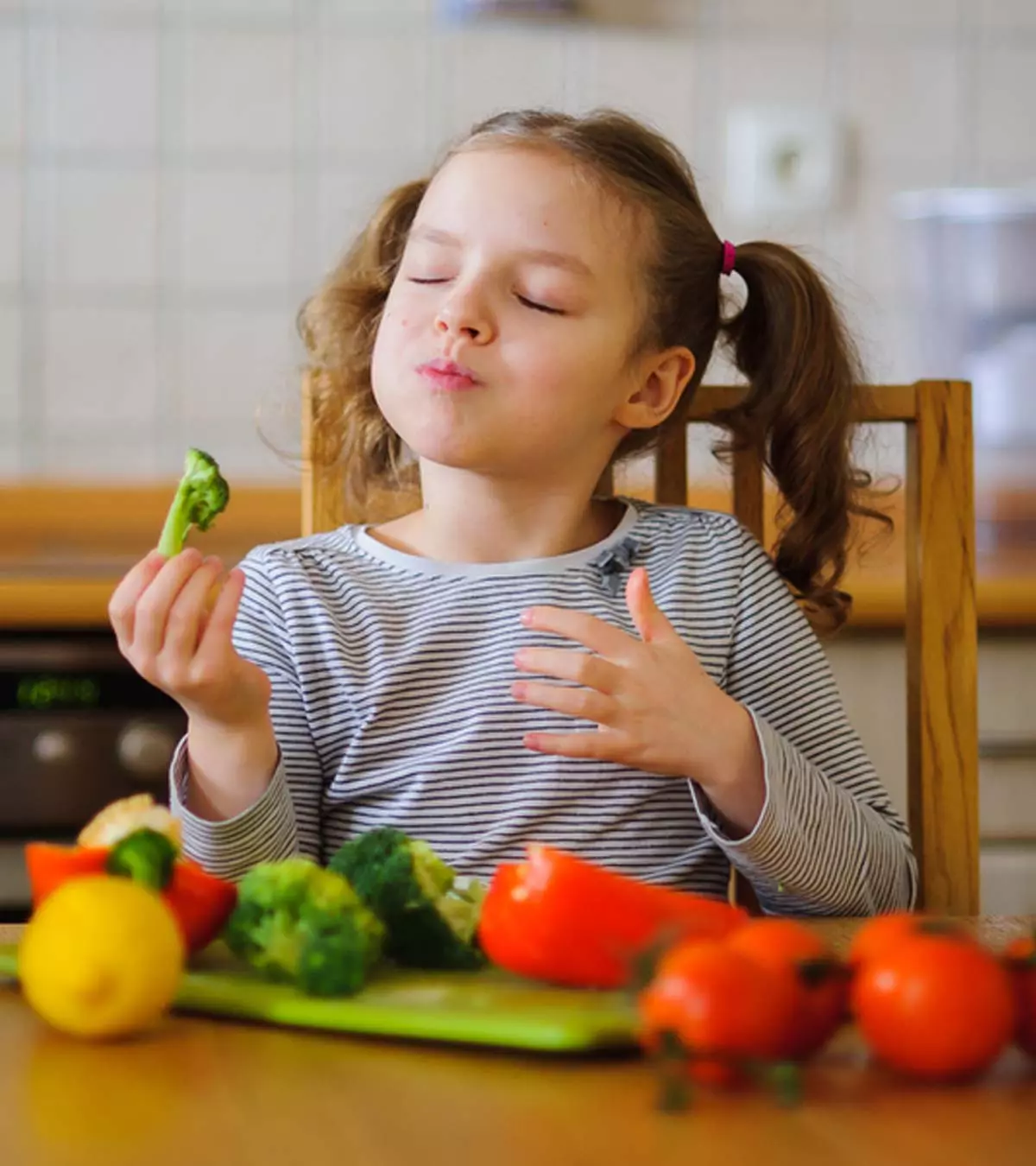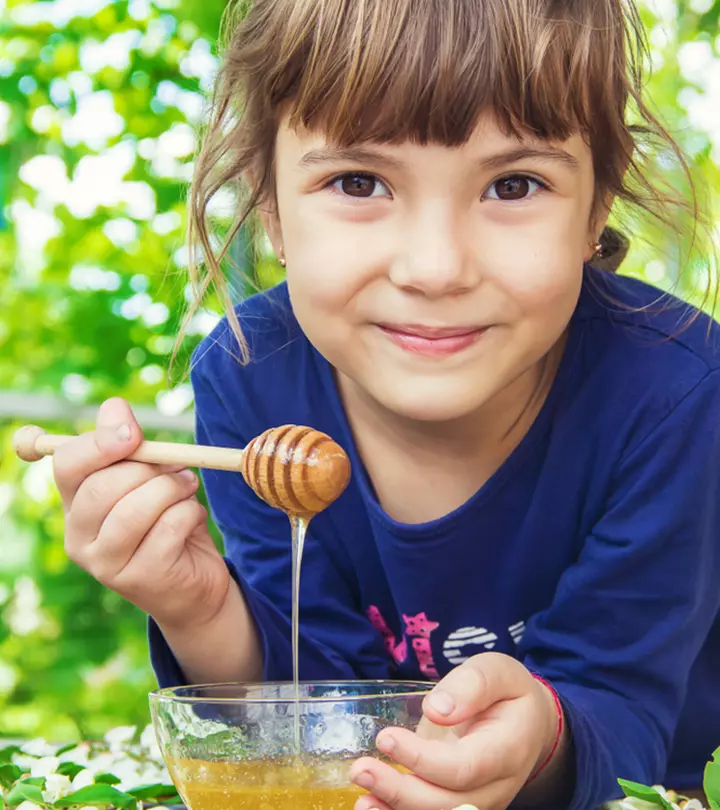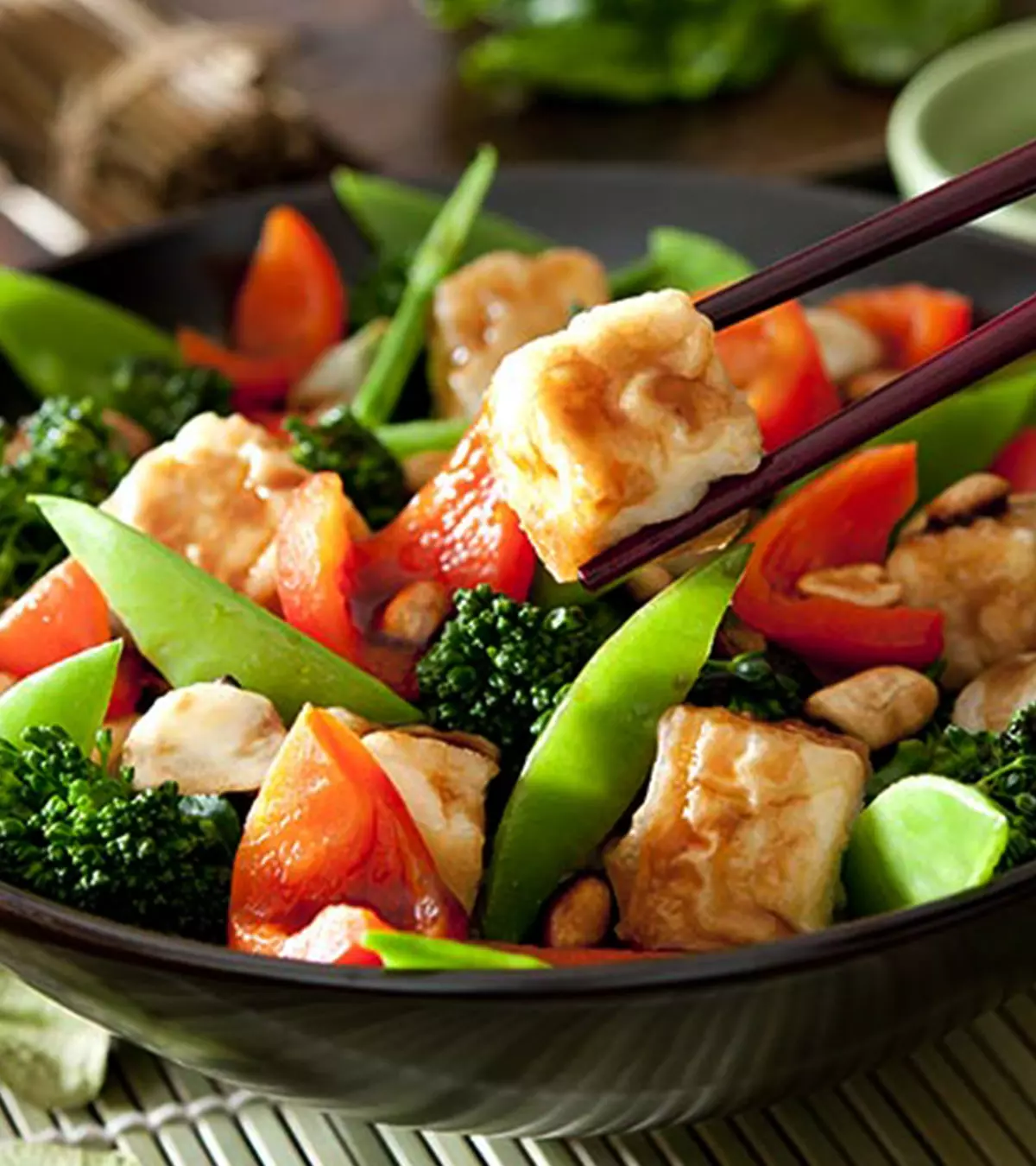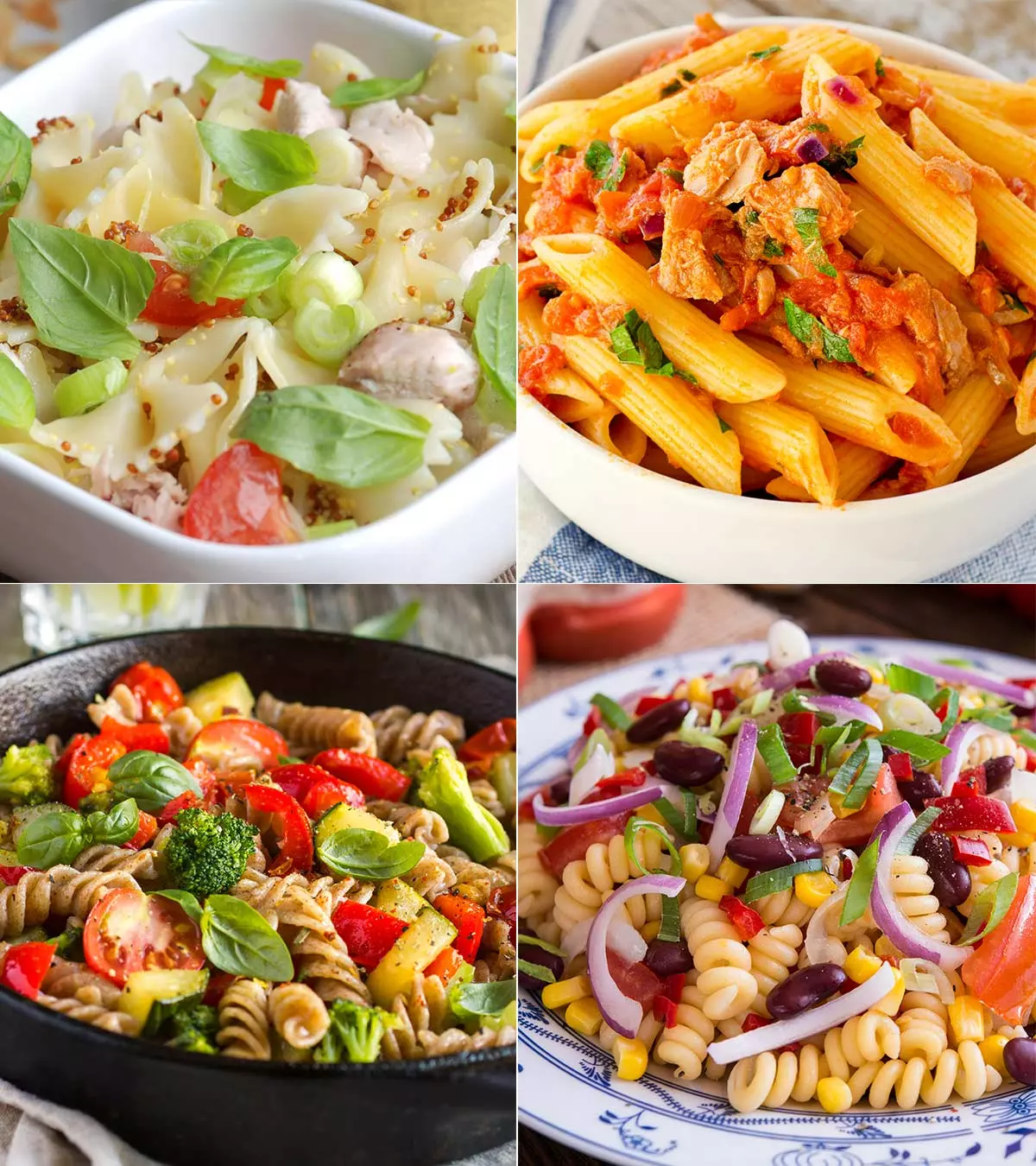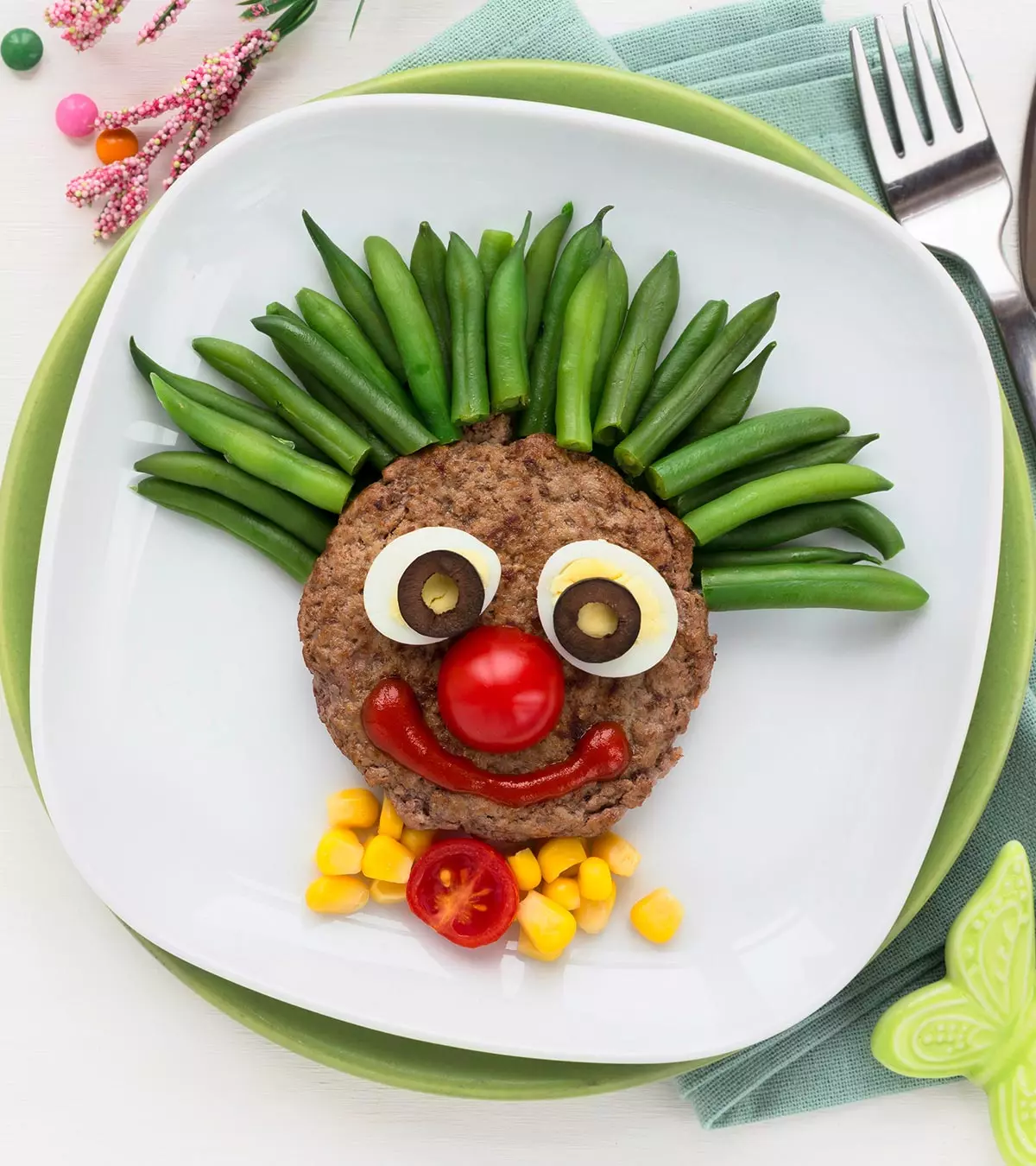
Image: Shutterstock
The benefits of high-fiber foods for kids and teens are numerous. Dietary fiber is a type of edible carbohydrate that is not easily digestible, although it provides several health benefits (1). There are two types of dietary fibers – soluble and insoluble – commonly found in plant-based diets.

However, the Dietary Guidelines For Americans (2015–2025) report states that kids are getting less fiber than they need due to decreasing intake of high-fiber foods such as vegetables and whole grains (2). As a result, this low-fiber diet may increase the risk of several conditions in the population, ranging from constipation to obesity (3) (4).
This post discusses some ways to increase the fiber in your child’s diet and some fiber-rich foods and the dishes you can make with them.
 Quick fact
Quick factKey Pointers
- AAP recommends children consume five servings of fruits, vegetables, and other fiber-rich foods to meet their daily fiber requirements.
- Oatmeal, beans, berries, bananas, and nuts are some foods rich in fiber.
- Replace refined flour with whole grains, and eat fruits and vegetables with peels to increase fiber intake.
- A few delicious recipes to try are banana and oatmeal porridge, three-bean veggie soup, and veg-loaded wholegrain pasta
How Much Fiber Do Children Need?
The recommended quantity of fiber for children varies as per their age, weight, and energy needs. The American Academy of Pediatrics (AAP) recommends at least five servings of fruits and vegetables with other fiber-rich foods to meet a child’s daily requirements of fiber (3).
The academy also recommends the “add five method” where you add five to the age of the child to arrive at the number of grams of fiber the child needs per day. For instance, if the child is ten years old, then they will need 15 grams of fiber per day.
The Academy of Nutrition and Dietetics recommends specific units of fiber as per the child’s age group (5).
| Age (years) | Fiber (grams per day) |
|---|---|
| 1 to 3 | 19 |
| 4 to 8 | 24 |
| 9 to 18 (girls) | 26 |
| 9 to 13 (boys) | 31 |
| 14 to 18 (boys) | 38 |
Source: Academy of Nutrition and Dietetics
What Happens When Children Consume Excessive Fiber?
Excess consumption of fiber through food is rare. According to the Academy of Nutrition and Dietetics, there is no tolerable upper limit set for dietary fiber. Therefore, there is no indicated intake level that can lead to adverse effects.
A very high intake of dietary fiber could lead to bloating, cramps, flatulenceiRelease of gas from the rectal region, commonly known as farting , sometimes constipation, reduction in appetite and early satiety, and diarrhea (6). They should drink enough water to help move fiber through the intestines. When paired with good hydration, fiber helps your digestive track move well. However, there is little evidence that these effects can occur in otherwise healthy growing children and teens.
Experts recommend consuming adequate amounts of dietary fiber from a well-balanced diet containing a wide variety of natural plant foods. The use of dietary fiber supplements for children needs pediatric guidance and should only be used if prescribed by the doctor.
15+ High Fiber Foods For Children
The natural sources of dietary fiber are fruits, vegetables, grains, cereals, nuts, and seeds. The good news is that these healthy foods for kids are tasty and you do not have to force it on your child. You can use these food groups in various combinations to prepare nutrient and fiber-rich dishes for your child.
Below is a list of high-fiber foods that your child can relish and reap health benefits from in the long run (7).
1. High-fiber bran ready-to-eat cereal
High-fiber bran cereals contain wheat bran and other fiber sources, like psyllium huskiA high fiber derivative of the seeds from the Plantago ovata plant, also used to treat constipation . The bran is an essential part of a whole-grain that provides high amounts of fiber, B-vitamins, iron, copper, zinc, magnesium, antioxidants, and phytochemicals (8). Read the nutrition label carefully and select options that contain:
- at least three grams of fiber from high-fiber foods, like whole wheat, whole-grain cornmeal, whole oats, whole rye, brown rice, etc. (3).
- less sugar and sodium per serving
Note:
Check for the ingredients carefully, especially if your child is allergic/intolerant to certain foods, like tree nuts, gluten, milk solids, etc.
2. Oatmeal
Oatmeal is made by processing natural oat grain to make rolled, instant, steel-cut, and other forms of oatmeal. Prefer oatmeal made from whole grain, which contains the husk/hull. It is a good source of soluble fiber, beta-glucaniThe natural fiber found in certain plants, microbes, and foods such as oats and barley , it provides 4g per cup cooked and essential micronutrients, like vitamin E, calcium, magnesium, and zinc that promote overall health and wellness. In addition, it can help manage weight (9). Oatmeal porridge, pancake, smoothie, muffins, etc. are some oatmeal recipes children can eat across different meals. You can make it your favorite by adding raisins, cinnamon, maple syrup, etc.
3. Beans
Beans are seeds of leguminous plants that are rich in protein, dietary fiber, with 16g of fiber in every 100g and essential nutrients, like lysineiAn amino acid that plays a vital role in regulating calcium absorption, collagen formation, and several other functions in the body , folateiNaturally occurring form of Vitamin B9, responsible for protein metabolism and the production of red blood cells , iron, and zinc (10). Feed your child a wide variety of beans to provide an assortment of fiber and nutrients. A few bean recipes for children include bean soup, bean stew, bean salad, bean curries, sauces/dips, etc.
4. Pears
Fresh pear with peel is a good source of dietary fiber, a medium size packs 5.5g of fiber and potassium, and bioactive compounds, like flavonoidsiA group of naturally-occurring antioxidant and anti-inflammatory compounds found in plants and fruits and anthocyaninsiNatural pigments found in plant-based foods that help in various body functions and possess therapeutic properties that promote health (11). For children, pear salad, pear sandwich, and pear shake are some mouth-watering recipes worth trying.
5. Apple
Apples with peel are a good source of both soluble and insoluble fiber, vitamin C, and phytochemicals that support overall health (12) A small apple has about 3.6g of fiber and every child loves the crunch and taste of an apple.
(13). You can give your child an apple as a midday snack or prepare tasty breakfast recipes, like apple cinnamon, apple oatmeal pancakes, apple bread, apple with peanut butter, which adds extra fiber too, and baked apple crisps.
6. Berries
Berries, like raspberries, blackberries, cranberries, etc. are colorful fruits that add flavor, color, and nutrition to your child’s diet. Whether consumed fresh, frozen, or canned, they provide significant quantities of dietary fiber, providing 4g of fiber for every half a cup and vitamin C and E, selenium, and healthy phytochemicals (14) (15).
7. Green peas
Green peas, fresh, frozen, or canned, contain 3.5 to 4.4 grams of dietary fiber per half a cup (7). Furthermore, they provide protein, essential micronutrients, and phytochemicals to support growth and development (16). Green pea sauce/dip/spread, roll, pancakes, and soups are some nutritious recipes that children enjoy to eat.
8. Banana
Banana is a good source of dietary fiber, with 3.g of fiber in a medium size and vital micronutrients like potassium, vitamin B6, vitamin C, and phytonutrients with antioxidant properties (17). You can use this nutrient-dense fruit to make various recipes, like shakes, smoothies, desserts, porridges, etc.
9. Avocado
Avocado is rich in vital nutrients like dietary fiber, packed with 7g of fiber in 100g and monounsaturated fatty acids (MUFA), and phytosterols (18). Avocado sauce/dip, salad, toast, and smoothie are some worthy recipes to try for children.
10. Sweet potato
It is a sweet-tasting root vegetable that children can consume in baked, grilled, boiled, or roasted forms. One medium-sized baked sweet potato provides 3.8 grams of dietary fiber and significant amounts of vitamin-A, potassium, and magnesium (7) (19).
11. Collards
Collards are green leafy vegetables from the cabbage family. One cup of cooked collards provides 3.8 grams of dietary fiber (7). Besides, it contains considerable amounts of glucosinolates, carotenoidsiColored pigments found in plant-based foods that act as a precursor in the vitamin A production , and fat-soluble vitamins, like vitamin-K, A, and E (20).
12. Dried fruits
Dried fruits are energy-dense dehydrated fruits containing considerable amounts of vitamins, minerals, dietary fiber, and certain bioactive compounds. Moderate consumption of dry fruits is associated with several health benefits in the long run (22). Dried fruits, such as prunes, pears, figs, and dates, can be included in porridge, shakes, smoothies, and desserts. Figs may have the highest fiber content of any dried fruit with 7.3g of fiber per half a cup.
13. Nuts and seeds
These are rich in vegetable protein, MUFA, PUFA, fiber, micronutrients, and phytochemicals (22). Some healthy nuts and seeds that you should serve to children in moderation are walnuts, almonds, pistachio, chia seeds, whole pumpkin seeds, and flaxseeds.
14. Whole rye
You can cook whole rye and serve it like you would serve other grains. Rye bread is high in fiber and has an impressive nutrient profile. Plain rye wafer/crackers are a fiber and nutrient-rich savory snack made of whole rye. Whole rye bread can be used to prepare sandwiches and rolls for your child.
15. Popcorn
Air-popped popcorn can be a considerable source of fiber (7), and it is also a food popular among children. You can serve it as a snack for children and teens across ages in moderate amounts. One cup of popped popcorn has almost one gram fiber. However, while preparing popcorn snacks, ensure to use little or no salt, sugar, and butter.
16. Chia seeds
You may also consider chia seeds for kids. They are a rich source of fiber that supports healthy digestion—one ounce of chia seeds offers about four grams of protein. These tiny seeds are packed with nutrients, including omega-3 fatty acids, calcium, and antioxidants, which contribute to a child’s overall growth and development (31).
Several other high-fiber foods and almost all plant-based foods have some amount of fiber. It is best to include moderate amounts of a wide variety of plant-based foods in the child’s daily diet.
Ways To Increase Fiber In Your Child’s Diet
Below are some tips that you can try to increase your child’s daily fiber intake.
- Include at least one serving of whole-grain or cereal per meal. Whole wheat flakes, whole-grain bread, whole-grain pasta, oats, wild rice, and millets are options to select. Whole grains contain more fiber than processed grains which helps in proper digestion.
- Read labels of packaged and processed foods and opt for low sodium, low sugar, and high fiber content. All-bran breakfast cereals containing wheat bran and psyllium husk are easily available over-the-counter. Choose high fiber snacks.
- Use oat bran or wheat germ to thicken soups, porridge, and add crunchiness to yogurt and fruit recipes.
- Replace refined or all-purpose flour with whole-grain/millet flour for cooking and baking recipes.
- Include at least one to two servings of a variety of beans and legumes in a day. Prefer making multi-bean recipes with plenty of fresh, seasonal vegetables.
- Serve at least five servings of whole fruits and vegetables in a day. Try to serve them raw or lightly cooked. You can also serve them as part of salads, sandwiches, smoothies, and soups.
- Encourage your child to consume fruits and vegetables with peels to enhance the fiber quality of the diet. as the maximum fiber is in the skin. Add them to recipes made from grains and cereals to intensify their nutritional value.
- Add whole seeds and nuts in powder or chunks to main recipes like salads, porridges, smoothies, shakes, etc. in moderate amounts.
- Choose high-fiber snacks, like air-popped popcorns, dry-roasted seeds and nuts, granola bars, nuts trail mix, whole wheat crackers, plain rye wafers, dried fruit, and vegetable chips.
In addition to the tips stated above, you can also try what Kate Dawn Smith, a mother to two, does to include fiber in her kids’ diet. She says, “I talk to my kids about the importance of fiber and other nutrients in their daily diet. We look at lists of foods that provide those nutrients and try to invent a salad or dish that appeals to them. I keep a color ‘Top High Fiber Foods’ chart on the refrigerator. It is often ignored but occasionally referenced. Those occasions make the printout worth it to me (i).”
 Quick tip
Quick tipDelicious High-Fiber Recipes For Children And Teens
Below are some delectable and customizable high-fiber recipes for children and teens.
1. Banana and berry oatmeal porridge

It is a yummy, nutrient, and fiber-rich breakfast recipe for children and teens.
You will need:
- 1 cup rolled oats
- 1 banana (diced)
- 1 cup mixed berries (chopped)
- 2 cups skimmed milk
- 1tbsp mixed nuts (chopped)
How to:
- Put oats, milk, and nuts in a thick bottom pan on medium heat.
- Cook the mixture with constant stirring (to avoid lumps) for ten minutes or until the mixture thickens.
- Switch off the flame, transfer the porridge to a serving bowl, and garnish with banana pieces and chopped berries. You can also add chia seeds or a dash of cinnamon. Serve while still warm.
2. Three bean veggie soup
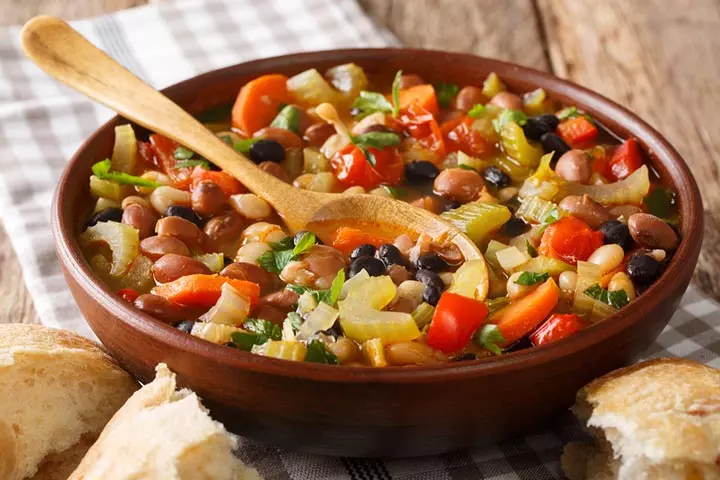
Three bean veggie soup is a dinner recipe with a delightful taste and high-fiber content.
You will need:
- 1 cup red kidney beans (cooked)
- 1 cup cannellini beans (cooked)
- 1 cup chickpeas (cooked)
- 1 medium-size onion (chopped)
- 1.15oz can of tomatoes (diced)
- 3 cups low-sodium vegetable broth (or homemade vegetable stock)
- 2 cup fresh spinach (chopped)
- 1 cup sweetcorn kernels (boiled)
- ½ cup carrot (peeled and diced)
- ½ cup green peas
- 1/4 cup pine nuts (toasted and chopped)
- 1tbsp vinegar
- 1tbsp coriander powder
- 1tsp paprika
- ¼tsp pepper powder
- Salt, to taste
- 2tbsp virgin olive oil
How to:
- Put a stockpot on medium heat, add olive oil, onions, and cook for about five minutes with constant tossing.
- Add tomatoes, coriander powder, paprika, pepper powder, vinegar, spices, and salt. Cook for another three to four minutes with the lid covered.
- Add vegetable broth, all the beans and vegetables, and let the mixture boil for five minutes.
- Next, cover the pan and cook the ingredients for 30 minutes or until the vegetables get tender.
- After 30 minutes, switch off the flame and let the soup come to room temperature.
- Transfer the soup to a serving bowl, garnish with pine nuts and serve immediately.
- If your child does not like bean chunks/pieces, then you can blend the ingredients into a puree using an immersion blender or food processor. It is a super healthy bean soup with low in fat and calories.
 Quick tip
Quick tip3. Green pea and cream cheese sandwich
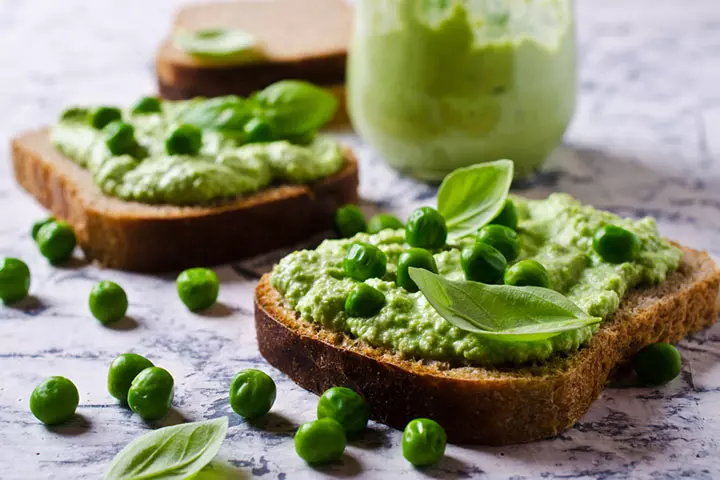
It is a flavorful, high-fiber sandwich recipe that can be served with boiled or scrambled eggs.
You will need:
- 4 slices whole rye bread
- 1 cup green peas (uncooked)
- ¼ cup cream cheese
- 1tsp herb mix
- 1tsp virgin olive oil
How to:
- Put olive oil in a flat pan, add peas and saute until they turn tender.
- Switch off the flame and let the peas come to room temperature.
- Blend cooked peas, cream cheese, and herb mix into a coarse paste and keep it aside.
- Lightly toast the bread slices on the same flat pan on medium heat.
- Transfer them to the serving plate, spread the green pea and cheese paste on them, and serve with boiled, deviled, or scrambled eggs.
4. Baked sweet potato wedges
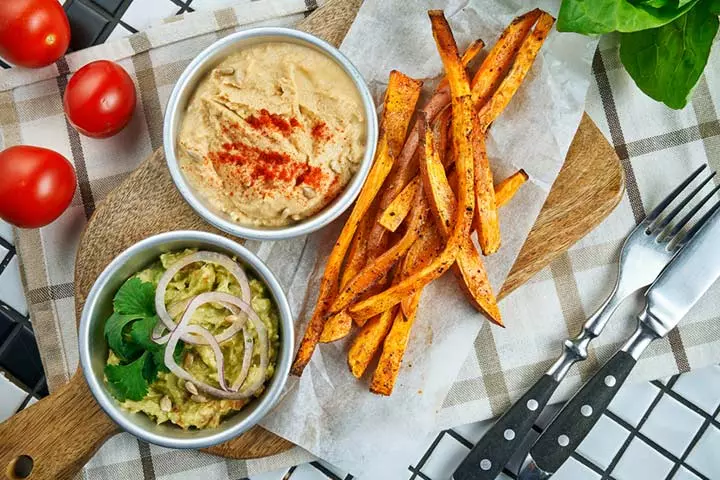
Sweet potato wedges are a flavorsome and nutritious midday snack for children and teens.
You will need:
- 2 small sweet potatoes
- 2tbsp garlic paste
- 2tbsp fresh parsley (chopped)
- 2tbsp fresh chives (chopped)
- 1tbsp avocado oil
- 1tsp herb mix
- Salt, to taste
How to:
- Preheat the oven to 415°F (212°C).
- Clean the sweet potato skin thoroughly and cut one-inch thick wedges.
- Mix sweet potato wedges with the remaining ingredients in a mixing bowl.
- Line a baking sheet with parchment paper, place the wedges on it, and bake for 15 minutes.
- Transfer the baked wedges to a serving plate and serve with homemade hummus or guacamole to add more nutrients, fiber and taste.
5. Veg loaded whole-grain pasta

The mouth-watering, nutrient-dense pasta recipe contains fiber and vitamins, minerals from various plant foods.
You will need:
- 1 cup whole-grain penne pasta
- 1 red onion (chopped)
- 1 cup mixed bell peppers (chopped)
- ½ cup button mushrooms (chopped)
- 1 cup fresh spinach (chopped)
- 1 cup sweet corn kernels (boiled)
- 2 cups tomato (chopped)
- 1tbsp garlic paste
- 1tbsp cheddar cheese
- 1tsp sesame seeds (roasted)
- 1tsp herb mix
- 2-3tbsp virgin olive oil
How to:
- Cook pasta as per the instructions given on the pack and set aside.
- Heat olive oil in a pan, add onions, garlic paste and sauté for two minutes.
- Add tomatoes, herb mix, salt, and cook the mixture until tomatoes turn mushy.
- Add all the remaining vegetables to the pan and cook with the lid covered for ten minutes.
- After ten minutes, add pasta to the veggie mix, and cook for another five minutes with occasional stirring.
- Transfer the pasta to a serving bowl, garnish with cheddar cheese and roasted sesame seeds, and serve.
6. Oatmeal muffins

A go-to snack that stuffs the goodness of fiber from oats and flaxseeds for an active teen.
You will need:
- 1 cup rolled oats
- 1¾ cup whole wheat flour
- 1 ripe banana (mashed)
- 1tbsp ground flax
- 3tbsps water
- ⅓ cup almond milk
- ¼ cup brown sugar
- ½ tsp baking soda
- ½ tsp baking powder
- ½tsp salt
- ½ tsp nutmeg powder
- ½ tsp cinnamon powder
- 3tbsp canola oil
- ¼ cup quinoa flakes
How to:
- Mix ground flaxseeds with water and keep the mixture in the fridge mixture for about 15 minutes.
- Set the oven to 400 F for preheating. Spray or put paper liners on a muffin tray and keep aside.
- Mix whole wheat flour, baking powder, baking soda, nutmeg powder, cinnamon powder, and salt in a bowl.
- Combine the flax mix, mashed banana, almond milk, canola oil, and brown sugar in a separate bowl.
- Gradually add the dry mixture to the bowl containing the wet ingredients. Mix in oats and quinoa.
- Divide the batter into the muffin tray and bake for 20 minutes. Check for doneness by inserting a toothpick at the center of a muffin. It is done if the toothpick comes out clean.
- Serve warm or store in the refrigerator for up to four days.
Frequently Asked Questions
1. Is the fiber content in peanut butter high?
Peanuts are a good source of fiber. However, how much fiber peanut butter contains depends on how it is processed. Generally, peanut butter containing peanut skin contains more fiber than peanut butter made with skinless peanuts (23) (24).
2. Do eggs have high fiber content?
Eggs are a good source of lean protein, vitamin D, and other essential vitamins and minerals. However, it doesn’t contain much fiber (25) (26).
3. What are the symptoms of fiber deficiency in children?
Fiber deficiency in children may manifest as constipation, irregular bowel movements, abdominal discomfort, allergies, and lowered immunity (27).
4. Does fiber help kids poop?
Fiber plays a significant role in helping kids poop regularly. It adds bulk to the stool, making it easier to pass through the digestive system (28). Fiber absorbs water and adds moisture to the stool, which helps prevent hard, dry stools that can lead to constipation.
5. How can parents encourage their children to eat more fiber-rich foods?
Parents can offer a variety of fruits, vegetables, whole grains, and legumes in appealing and creative ways to the children. Making fiber-rich foods enjoyable by presenting them in colorful ways, incorporating them into favorite recipes, or involving children in meal preparation can increase their interest and willingness to consume these foods.
6. Can high-fiber foods help children feel fuller for longer and reduce snacking between meals?
High-fiber foods can help children feel fuller for longer periods, reducing the likelihood of excessive snacking between meals. Fiber takes longer to digest, providing a greater sense of satiety and aiding in appetite control.
Children’s diets nowadays contain fewer high-fiber meals like vegetables and whole grains. Therefore, you must combine at least five servings of fruits and vegetables with other high-fiber foods to achieve their daily fiber requirements. Bran cereals, oatmeal, bananas, apples, beans, dried fruits, sweet potatoes, and other high-fiber foods for kids are popular among parents. You may add them to your meal preparations to provide more fiber, minerals, and flavor. Also, include your kid or teen in the meal preparation and grocery shopping, and teach them about nutrition and ingredient labels so they can make informed choices regarding high-fiber foods.
Infographic: Health Conditions Linked To Low Fiber Diet
Fiber is an essential component of food that helps prevent many common health problems. So when it is lacking, it may lead to uncomfortable and painful health issues. Read this infographic to learn about such conditions and understand why you must include fiber in your child’s diet.
Some thing wrong with infographic shortcode. please verify shortcode syntax
Illustration: High Fiber Foods For Kids With Delicious Recipes
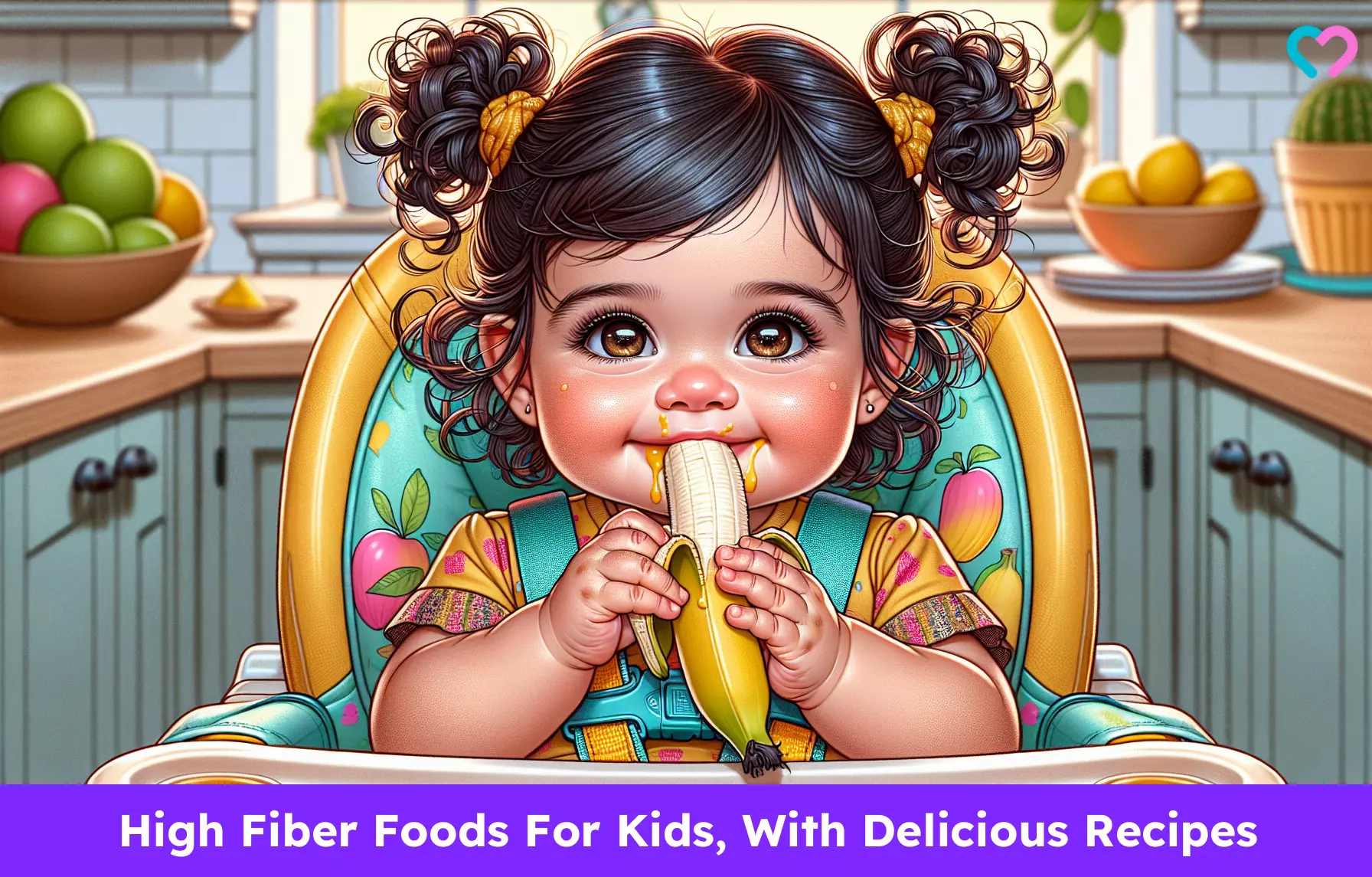
Image: Dall·E/MomJunction Design Team
Discover tasty and kid-friendly high-fiber foods in this video! From delicious meals to fun snacks, this video complies with several recipes that will come in handy for you.
Personal Experience: Source
MomJunction articles include first-hand experiences to provide you with better insights through real-life narratives. Here are the sources of personal accounts referenced in this article.
i. Adventures in autism: Five fiber fabs;https://medium.com/@escapevelocity_41812/adventures-in-autism-five-fiber-fabs-d07d46585711
References:
- Interactive Nutrition Facts Label; USFDA
https://www.accessdata.fda.gov/scripts/interactivenutritionfactslabel/dietary-fiber.cfm - Shifts Needed To Align With Healthy Eating Patterns; Dietary Guidelines For Americans 2015-2025
https://odphp.health.gov/our-work/food-nutrition/2015-2025-dietary-guidelines/guidelines/chapter-2/a-closer-look-at-current-intakes-and-recommended-shifts/#callout-nutrient-dense - Kids Need Fiber: Here’s Why and How; Healthy Children; American Academy of Pediatrics
https://www.healthychildren.org/English/healthy-living/nutrition/Pages/Kids-Need-Fiber-Heres-Why-and-How.aspx - Constipation in Children; Healthy Children; American Academy of Pediatrics
https://www.healthychildren.org/English/health-issues/conditions/abdominal/Pages/Constipation.aspx - Children Need Carbohydrates; Academy of Nutrition and Dietetics
https://www.eatright.org/health/essential-nutrients/carbohydrates/children-need-carbohydrates - Position of the Academy of Nutrition and Dietetics: Health Implications of Dietary Fiber; Journal of the Academy of Nutrition and Dietetics
https://www.jandonline.org/article/S2212-2672(15)01386-6/pdf - Appendix 13. Food Sources of Dietary Fiber; Dietary Guidelines For Americans 2015-2025
https://odphp.health.gov/our-work/nutrition-physical-activity/dietary-guidelines/previous-dietary-guidelines/2015 - Whole Grains; Harvard T.H Chan
https://nutritionsource.hsph.harvard.edu/what-should-you-eat/whole-grains/ - Oatmeal – Whole Grain Goodness; University of Nebraska–Lincoln
https://food.unl.edu/free-resources/newsletters/family-fun-run/oatmeal-whole-grain-goodness/ - All About Beans Nutrition, Health Benefits, Preparation and Use in Menus; North Dakota State University
https://www.ndsu.edu/agriculture/extension/publications/all-about-beans-nutrition-health-benefits-preparation-and-use-menus - Carol E. O’Neil1 et al.; Fresh Pear Consumption is Associated with Better Nutrient Intake, Diet Quality, and Weight Parameters in Adults: National Health and Nutrition Examination Survey 2001-2010; Longdom
https://www.longdom.org/open-access/fresh-pear-consumption-is-associated-with-better-nutrient-intake-diet-quality-and-weight-parameters-in-adults-national-health-and-nutrition-examination-survey-20012010-2155-9600-1000377.pdf - Apples; Harvard T.H. Chan
https://nutritionsource.hsph.harvard.edu/food-features/apples/ - Jeanelle Boyer and Rui Hai Liu; Apple phytochemicals and their health benefits; NCBI
https://pubmed.ncbi.nlm.nih.gov/15140261/ - Berry Good for Your Heart; Johns Hopkins Medicine
https://www.hopkinsmedicine.org/health/wellness-and-prevention/berry-good-for-your-heart - Arpita Basu et al.; Berries: emerging impact on cardiovascular health; NCBI
https://www.ncbi.nlm.nih.gov/pmc/articles/PMC3068482/ - Wendy J. Dahl et al.; Review of the health benefits of peas (Pisum sativum L.); Cambridge Universi8ty Press
https://www.cambridge.org/core/journals/british-journal-of-nutrition/article/review-of-the-health-benefits-of-peas-pisum-sativum-l/1C97E78717EF51A80A80D4E09A233AE8 - Chandrashekhar Vasant Kothawade; Medicinal and Nutritional Importance of Banana; Acta Scientific Agriculture
https://actascientific.com/ASAG/pdf/ASAG-03-0434.pdf - An avocado a day is good for your health; UT Southwestern Medical Center
https://utswmed.org/medblog/avocado-a-day/ - The Sweet Facts About Sweet Potatoes; California State University, Northridge
https://blogs.csun.edu/nutritionexperts/2019/06/10/the-sweet-facts-about-sweet-potatoes/ - Moo Jung Kim et al.; Glucosinolates, Carotenoids, and Vitamins E and K Variation from Selected Kale and Collard Cultivars; Hindawi
https://www.hindawi.com/journals/jfq/2017/5123572/ - Is eating dried fruit healthy?; Harvard Health Publishing
https://www.health.harvard.edu/topics/nutrition - Nuts and seeds; Better Health Channel; Victoria State Government
https://www.betterhealth.vic.gov.au/health/healthyliving/Nuts-and-seeds - Peanuts and peanut butter can be healthy; Harvard T.H. Chan School of Public Health
https://hsph.harvard.edu/mission-and-vision/ - Peanut skins-fortified peanut butters: effect of processing on the phenolics content, fibre content and antioxidant activity; National Library of Medicine
https://pubmed.ncbi.nlm.nih.gov/24128560/ - The Golden Egg: Nutritional Value, Bioactivities, and Emerging Benefits for Human Health; National Library of Medicine
https://www.ncbi.nlm.nih.gov/pmc/articles/PMC6470839/ - Fat-Fiber Counter; The University of North Carolina at Greensboro
https://ebccp.cancercontrol.cancer.gov/uploads/RTIPS/WHE/DoHHS/NIH/NCI/DCCPS/2583.pdf;jsessionid=D85B1D98F01FC2C2592DD8476E373C7D - Iva Hojsak et al., Benefits of dietary fibre for children in health and disease; NCBI
https://adc.bmj.com/content/107/11/973 - How Much Fiber Do Children Need?; Cleveland Clinic
https://health.clevelandclinic.org/figuring-dietary-fiber-child-need/#:~:text=Fiber%20can%20lower%20blood%20cholesterol,function%20and%20protecting%20against%20constipation.
Community Experiences
Join the conversation and become a part of our nurturing community! Share your stories, experiences, and insights to connect with fellow parents.
Read full bio of Seeemaa Budhraja
Read full bio of Swati Patwal
Read full bio of Rohit Garoo
Read full bio of Shinta Liz Sunny







